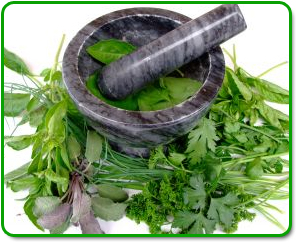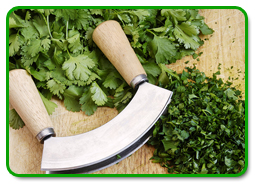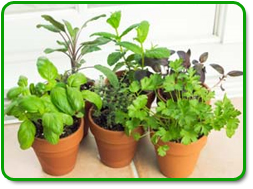|
| |
|
|
| |
|
|
| |
Guide to Growing Family Culinary Herbs |
| Guide to Growing Basil |
|
Guide to Growing Chives |
|
Guide to Growing Cilantro |
 |
Basil is a member of the mint family. Has a pungent flavor that some describe as a cross between licorice & cloves. |
|
 |
Related to the onion and leek. Chives have a mild onion flavor and are available fresh year-round. |
|
 |
Cilantro has a lively,
pungent fragrance that
some
describe as "soapy." |
| |
| Guide to Growing Dill |
|
Guide to Growing Fennel |
|
Guide to Growing Marjoram |
 |
The distinctive flavor of fresh dill weed in no way translates to its dried form. |
|
 |
The fennel base & stems can be eaten raw in salads used in braising, sautéing or in soups. |
|
 |
Marjoram can be used to flavor a variety of foods, particularly meats and vegetables. |
| |
| Guide to Growing Oregano |
|
Guide to Growing Parsley |
|
Guide to Growing Rosemary |
 |
Oregano is similar to marjoram but is not as sweet and has a stronger, more pungent flavor and aroma. |
|
 |
This slightly peppery, fresh-flavored herb is more commonly used as a flavoring and garnish. |
|
 |
An easy to grow perennial that enhances everything from eggs to bread to vegetables and meats. |
| |
| Guide to Growing Sage |
|
Guide to Growing Tarragon |
|
Guide to Growing Thyme |
 |
The narrow, oval, gray-green leaves of this pungent herb are slightly bitter and have a musty mint taste and aroma. |
|
 |
Tasting somewhat like Anise, Tarragon is mildly sweet and adds excellent flavor to sauces, soups, vegetables. |
|
 |
Thyme is widely used in cooking to add flavor to vegetables, meat, poultry & fish, soups & cream sauces. |
| |
|
| |
|
|
|
| |
|
Some tips on culinary herbs:
 Starting Herb Seeds Starting Herb Seeds
Herb seeds may require more care and patience than other types of seeds. We recommend starting all culinary herbs indoors in flats or small containers some weeks prior to the final frost of spring to make best use of sometimes rare and often expensive seeds. When sowing, use between 1-3 seeds per hole unless seeds are prone to low germination rates. Too many starts growing together can be difficult to separate later and both may show impaired development. If you do have 2 or more starts growing in close together, thin down to one and replant (or comsume) extra sprouts. After sowing cover flat (or container) with clear plastic lid or plastic wrap to retain moisture until seeds have started to germinate and poke through the soil-medium.
Soil for Herb Seeds
 Do not use garden soil or other soil from your yard to start culinary herbs. Such mediums may not be sterile and can be often contain mold or fungus which can be detrimental to germination seeds and young starts. Common soil may also contain excessive amounts of clay, which will not allow for proper drainage. Do not use garden soil or other soil from your yard to start culinary herbs. Such mediums may not be sterile and can be often contain mold or fungus which can be detrimental to germination seeds and young starts. Common soil may also contain excessive amounts of clay, which will not allow for proper drainage.
Always use a sterilized, organic potting medium that is rich in nutrient content yet offers good drainage. Your medium should be of a fine, rather than a coarse consistency, to ensure good seed-soil contact that will deliver the necessary moisture for germination. Keep your soil moist, especially prior to germination, and be gentle when watering so as not to disturb your seeds, especially tiny seeds which may be sown at a very shallow depth or on top of the soil. A spray bottle, saturated paper towel, or very gentle water can may be the best bet in such cases.

Planning your Herb Garden
When planning your culinary herb garden, find a convenient spot near your home so your herbs are close at hand come dinner time. Unless you are drying your herbs for future use, use them as soon as possible after collecting. For best flavor and to discourage wilting, try to harvest your culinary herbs early in the morning or later in the day away from the intensity of the mid-day sun.
Transplanting your Herbs
Transplant outdoors once the average date of the final frost of the spring has passed. Most starts will be ready for transplanting with the appearance of their first (or second) set of true leaves, not to be confused with cotyledons, the first leaf-like structures to appear. If starting in flats or shallow containers, do not wait too long to transplant as the roots can become stifled in the bottom of your container and inhibit development and growth later on.
For best results, gradually 'harden' plants for outdoor transplanting by exposing in increasing amounts of sunlight and outdoor conditions, but do not leave containers outdoors overnight if concerned about spring freeze. Try to transplant on a cloudy overcast day to minimize the possibility of immediate shock from sunlight and heat.
Maintaining your Herb Garden
Annual herbs cultivated for the leaves, such as Basil, Cilantro and Dill should be replanted every four to six weeks during the growing season to ensure a steady supply of herb. Perennial herbs, including Rosemary, Oregano, Thyme, Sage and others many need special attention at the beginning and end of the season, including: pruning for better airflow or to promote optimum growth, mulching to protect the root structures in winter months, and cutting back in preparation for cool season.

|